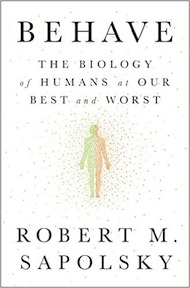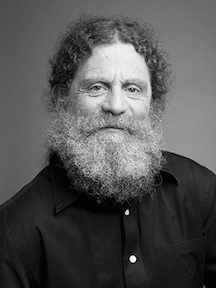By Matthew Zyle
From Palo Alto to the savannas of Kenya, Robert M. Sapolsky (ΦBK, Harvard College, 1978) works to uncover the biological explanations behind many of the daily challenges facing modern humans.
A professor of neurology at Stanford University, Sapolsky can be found in Kenya studying stress and disease in baboons when he is not working in the lab back at home. His career has spanned more than thirty years and includes a number of awards and accomplishments ranging from the MacArthur Foundation “genius” fellowship to the Carl Sagan Prize for Science Popularization, making him highly recognized within the scientific community as well as among general readers. He has authored numerous books on primatology, neuroscience, and behavioral studies, including Why Zebras Don’t Get Ulcers (1994), The Trouble with Testosterone and Other Essays on the Biology of the Human Predicament (1997), and A Primate’s Memoir (2002), prompting The New York Times to label him as “one of the finest natural history writers around.”
In a recent interview with Psychology Today, Sapolsky discussed his forthcoming book, Behave: The Biology of Humans at Our Best and Worst, which draws upon more than ten years of work in an attempt to formulate an explanation for a seemingly simple, yet highly complex question: Why do we do the things we do?
Beginning with the milliseconds preceding an action, Sapolsky takes readers on a journey to show how a variety of processes – including neural, hormonal, cultural, and evolutionary mechanisms – each play a role in determining a person’s behavior in a single moment. By drawing on research from a variety of fields, Sapolsky aims to show readers that the most fascinating thing about human behavior is not the underlying mechanisms of neurons and muscles, but the meanings that guide each choice.
“Pulling a gun’s trigger can be an appalling act,” he says. “But if it is suicidally drawing fire to save someone, it has an utterly different meaning. Placing your hand on someone’s arm can be an act of deep compassion or the first step of betrayal.”
In addition to analyzing how context is linked to certain actions, Sapolsky tackles additional biological bases that differentiate humans from other species (such as the primates he has studied throughout his career) as well as general tendencies that are apparent in human behavior.
One such response Sapolsky addresses is the “Us and Them” dichotomy, the inherent basis for why humans tend to differentiate between people who are similar to and different from themselves.
“Brains distinguish between an Us and a Them in a fraction of a second,” he says. “Subliminal processing of a Them activates the amygdala and insular cortex, brain regions that are all about fear, anxiety, aggression, and disgust.”
Though these seemingly negative responses to people different from oneself may be wired into human behavior, Sapolsky argues that manipulating how individuals determine whether someone is an “Us” or a “Them” is actually quite simple, an observation that drastically changes the assumption that these negative behaviors are biologically unavoidable.
“I think it is inevitable that we make Us/Them distinctions, but there’s nothing inevitable about who counts as a Them,” he adds.
Sapolsky addresses several other puzzling human behaviors and their biological roots, such as why different people seek out certain levels of “good stress” in the forms of scary movies or roller coasters, as well as the question of whether free will or determinism is the basis of human action. By bringing together analyses from a range of scientific fields, Sapolsky ultimately aims to paint a biological history of human behavior that encapsulates the full journey of what are often routine actions, from their evolutionary roots stretching back several thousand years all the way to the preceding milliseconds.
Behave: The Biology of Humans at Our Best and Worst is forthcoming from Penguin Press May 2 and is currently available for pre-order.

Matthew Zyle is a junior at Case Western Reserve University double majoring in English and computer engineering. Case Western Reserve is home to the Alpha of Ohio Chapter of Phi Beta Kappa.




